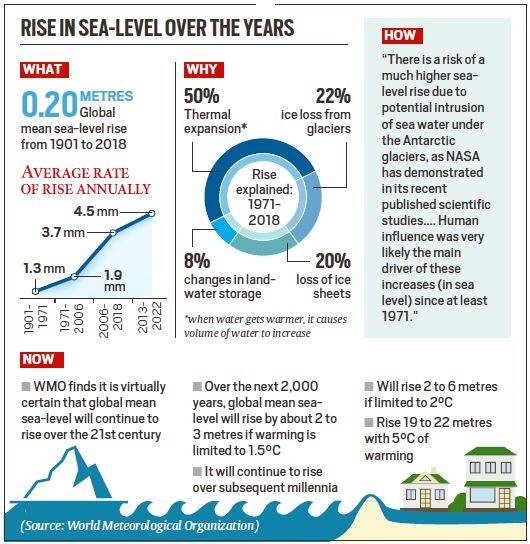Description

Copyright infringement not intended
Context: India, China, Bangladesh and the Netherlands face the highest threat of sea-level rise globally, according to a new report by the World Meteorological Organization (WMO).
Details:
Findings of the report:
- The report — “Global Sea-level Rise and Implications” — stated that several big cities in all continents are threatened by the rise in sea level.
- These include Shanghai, Dhaka, Bangkok, Jakarta, Mumbai, Maputo, Lagos, Cairo, London, Copenhagen, New York, Los Angeles, Buenos Aires and Santiago.
- It is a major economic, social and humanitarian challenge.
- Sea-level rise threatens coastal farmlands and water reserves and resilience of infrastructures as well as human lives and livelihoods, the report noted.
- The impacts of average sea-level rise are boosted by storm surges and tidal variations, as was the situation during the landfall of hurricane Sandy in New York and Cyclone Idai in Mozambique.
- According to future estimates based on climate models and ocean-atmosphere physics, the WMO reported that the speed of melting of the largest global ice mass in Antarctica is uncertain.
- While sea-level rise is not globally uniform and varies regionally, continued and accelerating sea-level rise will “encroach on coastal settlements and infrastructure and commit low-lying coastal ecosystems to submergence and loss”, according to the report.
- If trends in urbanization in exposed areas continue, this will exacerbate the impacts, with more challenges where energy, water and other services are constrained.
- Climate change will increasingly put pressure on food production and access, especially in vulnerable regions, undermining food security and nutrition and increases in frequency, intensity and severity of droughts, floods and heatwaves, and continued sea level rise will increase risks to food security in vulnerable regions.
- According to WMO, the population potentially exposed to a 100-year coastal flood is projected to increase by about 20% if global mean sea level rises by 0.15 metres relative to 2020 levels.
- This exposed population doubles at a 0.75-metre rise in mean sea level and triples at 1.4 metres rise without population change.

Case studies:
- Mumbai:Around 998 buildings and 24 km of road length will be affected by potential sea-level rise by 2050.
- Chennai: road length of 5 km and 55 buildings are at the risk; in Kochi, around 464 buildings are likely to be impacted by 2050 with the number rising to around 1,502 buildings during high tide.
- Thiruvananthapuram: due to sea-level rise by 2050 and sea-level rise with high tide, 349 and 387 buildings, respectively, are likely to be impacted.
- Visakhapatnam: Around 206 buildings and 9 km of the road network are likely to be inundated due to potential coastline changes by 2050.
.jpeg)
What’s causing sea level to rise?
- Global warming is causing global mean sea level to rise in multiple ways.
- First, glaciers and ice sheets worldwide are melting and adding water to the ocean.
- Second, the volume of the ocean is expanding as the water warms.
- Third, much smaller contributor to sea level rise is a decline in the amount of liquid water on land—aquifers, lakes and reservoirs, rivers, soil moisture. This shift of liquid water from land to ocean is largely due to groundwater pumping.
Consequences of Sea level rise:
- Devastating effects on coastal habitats farther inland
- Destructive erosion
- Wetland flooding
- Threatens infrastructure necessary for local jobs and regional industries.
- Aquifer and agricultural soil contamination with salt
- Threatening farmland, housing or recreation areas.
- Lost habitat for fish, birds, and plants.
How drowning of cities can be prevented?
- Land reclamation
- Increasing the height of roads
- Strengthening buildings against corrosion or relocating them.

World Meteorological Organization (WMO)
- It is an intergovernmental organization with a membership of 193 Member States and Territories.
- It was established by the ratification of the WMO Convention in 1950.
- WMO became the specialised agency of the United Nations for meteorology (weather and climate), operational hydrology and related geophysical sciences a year later.
- The UN Economic and Social Council is the parent organization of WMO.
- WMO is headquartered at Geneva.
- WMO is dedicated to international cooperation and coordination on
- the state and behaviour of the Earth’s atmosphere, its interaction with the land and oceans,
- the weather and climate it produces, and
- the resulting distribution of water resources.
- It facilitates and promotes
- the establishment of an integrated Earth System observation networkto provide weather, climate and water-related data
- the creation of standardsfor observation and monitoring
- the provision of weather, climate and water-related services - to reduce disaster risks and contribute to climate change adaptation etc.
- the coordination of research and trainingin meteorology and related fields
- Major reports published by the WMO are - Status of World Climate; Greenhouse Gas Bulletin.


https://indianexpress.com/article/india/mumbai-dhaka-london-new-york-among-metros-in-line-of-sea-level-rise-threat-report-8445371/

















